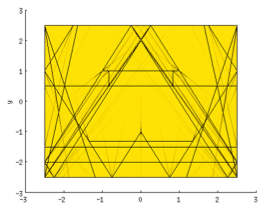By using HRIRs (Head Related Impulse Responses), it is possible to induce spatial impressions of sounds played to human beings via headphones. However, as HRIRs are usually recorded in anechoic chambers, they convey a relatively unnatural impression of the simulated hearing environment, as in most real environments, echos can be heard. Furthermore, HRIRs do not include information about the distance of sound sources, which is another limiting factor.
These problems can be remedied by combining HRIRs with room impulse responses. Due to the effort required to measure room impulse responses at several positions in a room, we calculate artificial room impulse responses with a beam tracing approach, and combine them with HRIRs in order to enable realistic spatial hearing.
In our tests, we compared the resulting reverberant HRIRs with non-reverberant KEMAR HRIRs. The participants of the test generally produced more errors when asked to determine the direction of a sound with reverberant HRIRs than with non-reverberant HRIRs. However, as studies indicate, HRIRs with reverberation as ours are likely to reduce in- head-localization errors, which is a desired feature.
Applications which could benefit from realistic spatial hearing include hi-fi audio systems, conference solutions and tele-environments.
